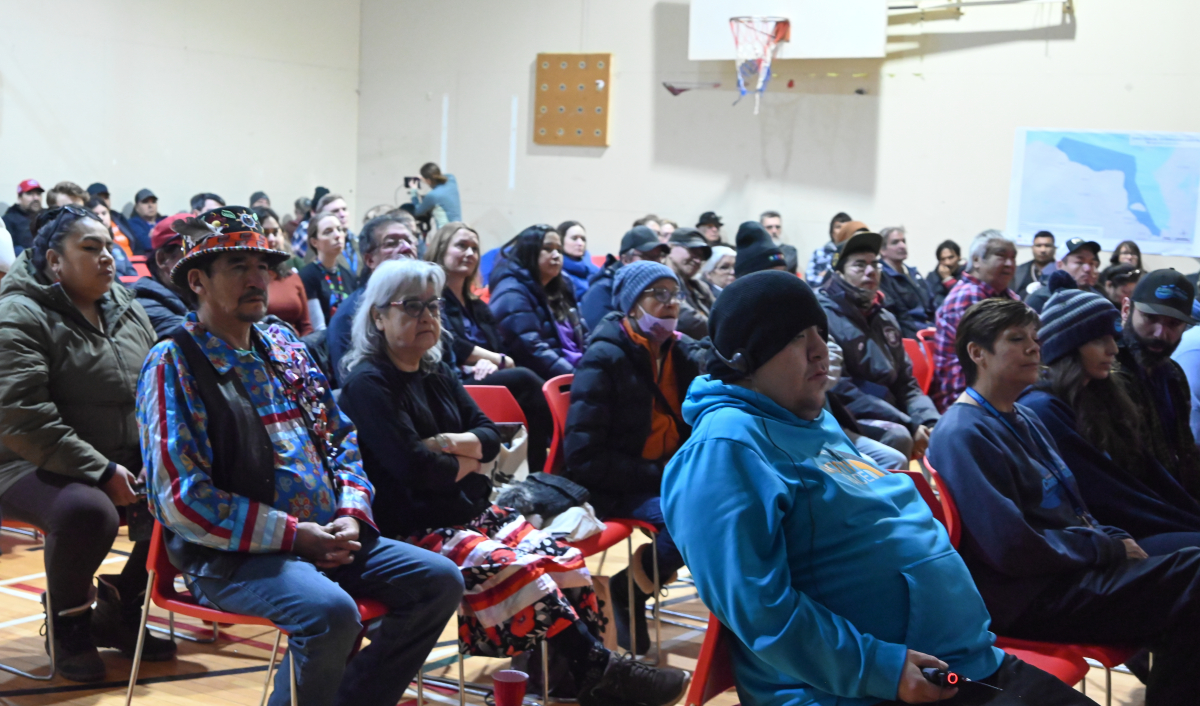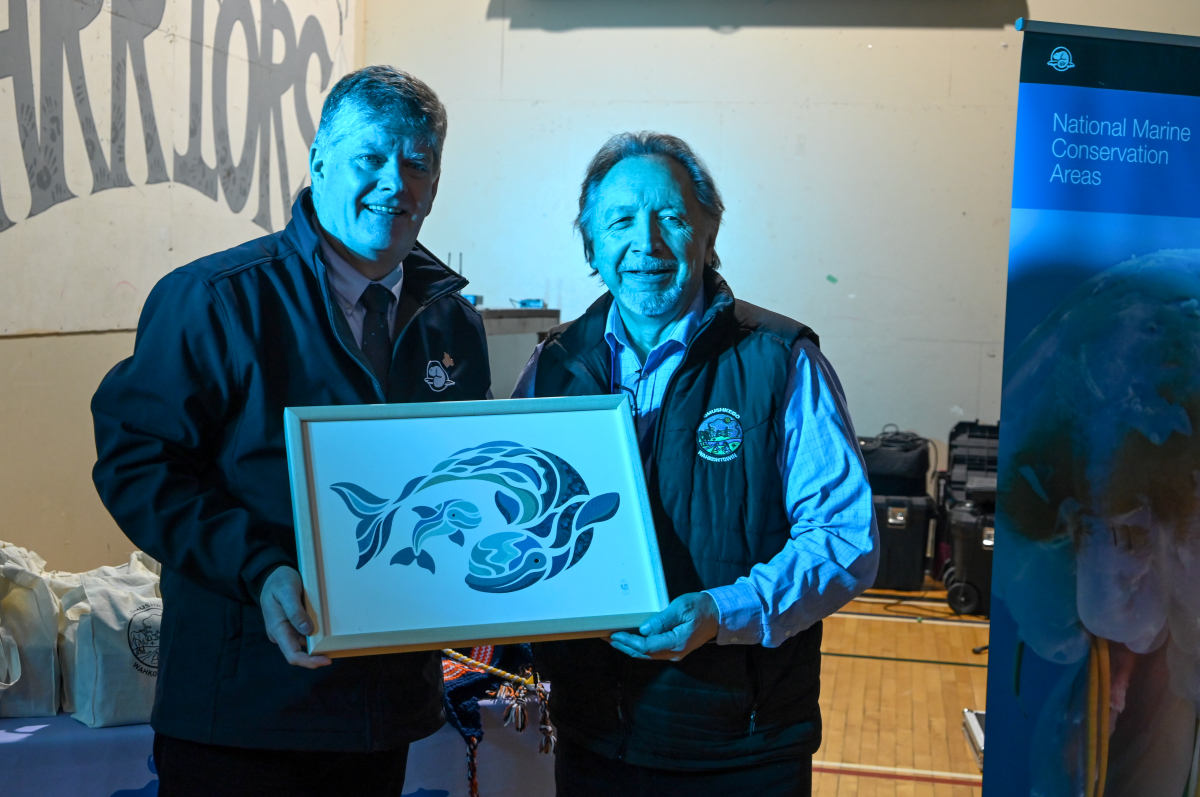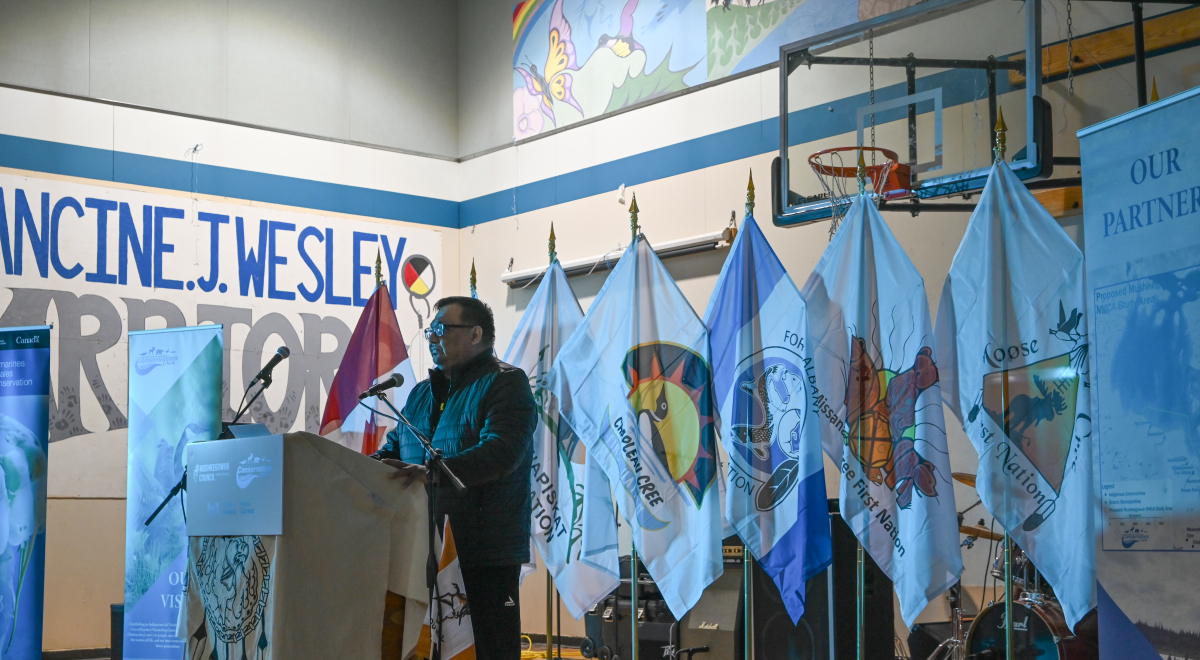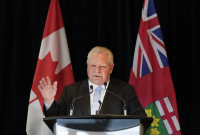Support strong Canadian climate journalism for 2025
Around 100 people gathered this week in the Kashechewan First Nation High School gym to celebrate a milestone in the creation of a new Indigenous-led Marine Conservation Area on the James Bay coastline.
Once established, the project will be ultimately managed by a partnership of Parks Canada and the Mushkegowuk Marine Conservation, which includes eight Mushkegowuk First Nations as well as Fort Severn and Peawanuck First Nations.
The project is called Omushkego Wahkohtowin, which means "people with the right relationship to the land and waters."
But amidst upbeat speeches and a countdown to live music, there was at times tense concern and distrust of land and water agreements with the government.
It was an informal setting, where some attendees were on their phones and others talked to each other seated in rows of orange plastic chairs. On the menu was coffee, hamburger soup and a sandwich of ham, butter and processed cheese on brown bread.

The federal announcement that the feasibility study had finished for the conservation area was made by Adam van Koeverden, a former Olympic rower and now MP for Milton. He is also the acting parliamentary secretary to Environment Minister Steven Guilbeault, and on this day, was filling in for his boss.
“Anybody who has paddled before knows that when we put our paddles in at the same time, we tend to make more progress,” he said to the gathered crowd.
His speech was practised and polished, with a personal dimension referencing his career-winning medals for Canada.
“We have taken a major step forward, or maybe even a couple strokes forward to achieving.”
At this point, a community member stood up and interrupted with an impromptu speech about the project. His remarks urged Indigenous youth to stand up for their homelands and question government officials about the project, a message echoed by some of the First Nations chiefs in attendance.
This obvious distrust and skepticism point to the novelty of Indigenous-led conservation in Canada, and Omushkego Wahkohtowin will be one of the first of its kind.
Earlier this year, the Seal River Watershed, another Indigenous Protected Conservation Area (IPCA), announced the beginning of a feasibility study this year. The James Bay Marine Conservation Area is further ahead. The federal government and nine First Nations that compose the Omushkego Wahkohtowin marine conservation project are now looking to sign their establishment agreements under tight timelines, as a federal election looms.
It remains to be seen what “Indigenous-led” will even mean until those finalized agreements are signed. Lawrence Martin, Mushkegowuk Marine Region manager, said a negotiation team will be assembled and ready for talks in April. It’s unclear how long the negotiations will last, but it could be as short as six months to two years.
Consensus among leadership and community members is not unanimous.
“For some people, it seems like we’re rushing,” Martin said. “But we’ve been at this for the last 50 years,” he said, pointing to resolution after resolution to pressure Ottawa for movement. Now is the time as Ottawa scrambles to protect 30 per cent of its lands and water by 2030 to meet its Global Biodiversity Framework targets set at COP15 in Montreal.
But it’s also not surprising to see community members speak out and worry about Ottawa manoeuvring in bad faith.
Distrust of Ottawa is deep-seated in historical and current injustices, particularly for northern First Nations. Generations have seen their children taken, first to residential schools and more recently, by the child welfare system. As well, the education system has many students leave as young as age 13 to attend high schools in bigger municipalities like Thunder Bay and Timmins.

Still, Martin and other leadership point to the opportunity of protecting the James Bay watershed, an essential habitat for migratory bird species, polar bears, belugas and many other flora and fauna sensitive to climate change and development.
The project will be larger than the size of Austria and will protect around 1.5 per cent of the 30 per cent conservation targets. It also carries the extra cultural benefit of providing work to land users and providing educational materials based on the feasibility study.
It’s still unclear how much of the designated land will ultimately be protected as part of the region’s project for permanence that will be financed by donors, Ottawa and Queen’s Park. Ontario remains an unwilling player in conservation of the land as they “haven’t even spoken to us,” Martin said. It’s a problem as an Ottawa-set deadline for the land part of the project looms for June 30.
In Canada, waters remain a federal jurisdiction, whereas Crown land remains the realm of the provinces.

Martin looks to his Cree kin to the east in Quebec. The Eeyou Istchee, or the Cree Nation government, is in talks with community members, Ottawa and Quebec to establish a mirrored conservation area on their side of the bay. But it was only in the last four weeks that Quebec reached out to Eeyou Istchee to work with them.
It’s still unclear how successful this new push for conservation will be, given the critical mineral strategy within both Ottawa and several provinces that will accelerate the development of mining in Canada’s northern regions.
The question then becomes: What balance will be shown between protecting biodiversity and transitioning into the new industrial era of electrification?
The travel to Kashechewan First Nation was provided by the Mushkegowuk Council.
Matteo Cimellaro / Local Journalism Initiative / Canada’s National Observer






Comments